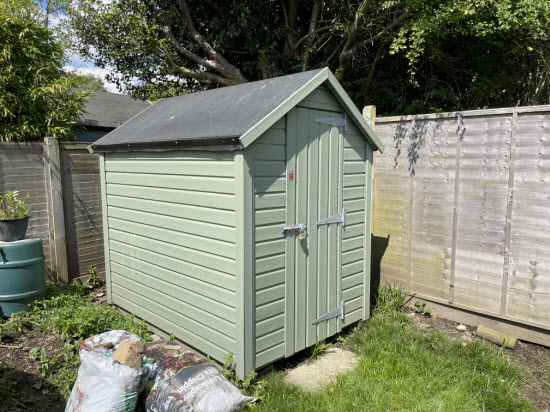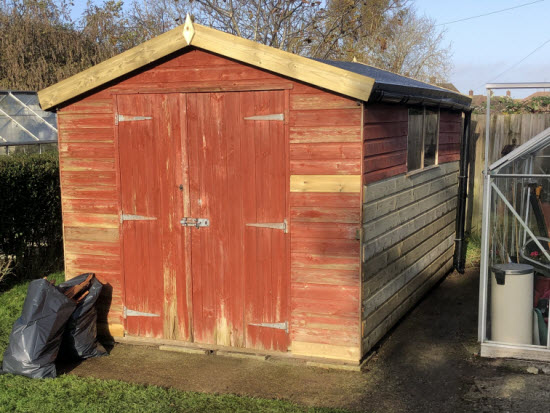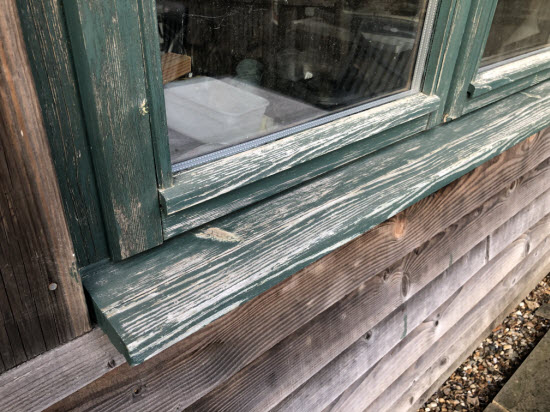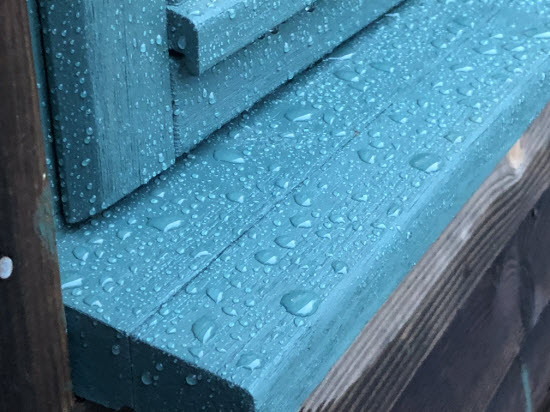Exterior Woodstain Explained: Why Painting Your Shed Could Be a Costly Mistake
When I See Paint on a Shed, I See Trouble
Every so often, I'm asked to repair a shed that looks like it should be salvageable-until I walk up close and see the telltale signs. Peeling paint. Blackened timber. Mushy corners. And the owner says something like, 'We gave it a good coat of paint a few years back.'
That's usually all I need to know.
Because in almost every case where a shed is rotting earlier than it should, it's been painted, not stained. And that one choice can make all the difference.
Most people know now that shed stain is the right way to go. But for those who are still thinking of rolling on a coat of exterior gloss or grabbing leftover emulsion from the garage... let's talk.
 Shed looking good 3 years after coating with exterior woodstain
Shed looking good 3 years after coating with exterior woodstain
Paint vs. Exterior Woodstain: Why One Protects and the Other Traps Moisture
Here's the Big Idea:
Paint is impervious. That sounds good-until it cracks.
When it does (and it always does), water gets in behind the paint film. But because the paint is impermeable, the water gets trapped. And that's when the timber starts to rot from the inside out.
Exterior woodstain doesn't behave like this. It:
- Soaks into the timber instead of sitting on top
- Allows the wood to breathe, so moisture can escape
- Contains waxes to help water bead and run off
- Is flexible and easy to reapply without sanding back to bare wood
And perhaps best of all-it looks great and stays looking great with minimal maintenance.
 This shed was in need of re-coating. I had to replace a large section of siding which had decayed partially due to lack of coating and partially due to the
lack of a gutter to collect rainfall (now installed)
This shed was in need of re-coating. I had to replace a large section of siding which had decayed partially due to lack of coating and partially due to the
lack of a gutter to collect rainfall (now installed)
Misunderstandings That Lead to Rotten Results
'But I used paint on the shed doors and they're fine!'
Yes-and that might be okay. Joinery-grade timber, such as that used for shed windows and doors, is more stable and less likely to move or crack. Paint can work on these if you:
- Sand back to sound wood before repainting
- Regularly inspect for cracks and water ingress
But the wide, exposed boards that make up most shed walls? They move. They breathe. They twist. And that's where paint falls apart-literally.
'What about varnish?'
Varnish is worse. It's a hard, clear coating that looks fantastic initially. Then it cracks. Water gets in and areas start to look a bit 'misty', water is trapped. And before you know it, that beautiful golden glow has changed to a patchwork of black and grey and needs some urgent attention.
How to Use Exterior Woodstain the Right Way
Step 1: Start With Clean, Dry Timber
Whether your shed is brand new or just new to you, it's important to remove any dirt, mould, or loose fibres. Use a stiff brush, not a pressure washer, and let the timber dry completely before applying any stain.
Step 2: Choose a Quality Exterior Woodstain
Look for a breathable, water-repellent woodstain that includes waxes or resins for added water resistance. Avoid 'decorative fence paints' or opaque finishes that behave more like paint than stain.
Brands to consider: Osmo, Sadolin, or Ronseal 'Shed & Fence' ranges
Step 3: Apply With a Brush or Roller
Work in manageable sections. Apply with the grain. You'll usually need 2 coats for new timber, with 4-6 hours drying between coats (check manufacturer guidance).
When Should You Re-Stain a Shed?
Watch for the Bead Test
The easiest way to tell if your shed needs a fresh coat of woodstain is to spray or splash water on the surface.
- If the water beads and runs off, you're good.
- If it soaks in quickly, it's time to re-stain.
 This shed window was well over due a protective coating. When it rained water soaked into the wood, promoting cracking and decay.
This shed window was well over due a protective coating. When it rained water soaked into the wood, promoting cracking and decay.
 Shed window after a coat of exterior woodstain. Water beading nicely ;-)
Shed window after a coat of exterior woodstain. Water beading nicely ;-)
Generally, plan to reapply every 3-5 years, depending on:
- How exposed your shed is to sun and rain
- The quality of the product used
- How thoroughly you cleaned and prepared the surface last time
Other Ideas for Painting a Shed (That Aren't Actually Paint)
Want to get creative with colour while still using the right product?
Many high-quality woodstains come in tinted shades, from natural pine and cedar to charcoal grey, green, or even slate blue. These give you the look of 'paint' with the performance of stain.
If you're looking for ideas for painting a shed, start by searching tinted exterior stains instead of paints. You'll get longer-lasting results and a more natural finish.
Final Thought: Back to That Rotten Shed
That shed I mentioned at the start? The one coated in proud, cracking layers of white gloss?
We couldn't save it.
The moisture had soaked deep into the boards. The baseplate was gone. The panels flaked off in damp chunks.
So, if you're planning to treat your shed this weekend, do yourself (and your timber) a favour: Put the paint down. Pick up a breathable, water-repellent exterior woodstain instead.

Keep in touch with our monthly newsletter
Shed Building Monthly




